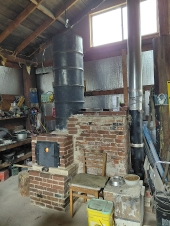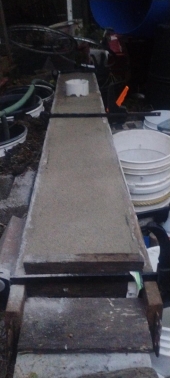Ok, so this guy was inspired by the Anila stove.
I don't like his loading/unloading mechanism, but I do like the blower separated from the burn chamber.
He reports that it takes 4 hours of burn time to pyrolize the feedstock, and described feeding the fire during that time.
That sounds terrible to me, but there is some differences in planned uses and designs between he and I.
I want an all in one fuel + charcoal feedstock cartridge that can be swapped in and out of an outdoor boiler.
The ease of loading and unloading is important to me, because I hope to be heating my house this way in my old age.
If he filled the center cylinder I think it would hold less than a 1/2 gallons of fuel, compared to to the nearly 4.5 gallons of charcoal feedstock.
I think a ratio of fuel to feedstock of 1 to 3 would be reasonable, assuming the feedstock looses a third of its volume during pyrolosis.
For context, a roughly 6" diameter circle has about a 4th the area of a 12" diameter circle, so a reactive stove with a 6" dia inner cylinder and a 12" diameter outer cylinder would have that 1/3 ratio.









